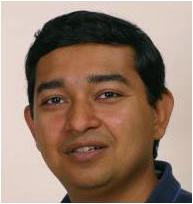EWSN 2018 Keynotes
Edge Computing in the Extreme and its Applications (Main Conference)

Suman Banerjee
University of Wisconsin-MadisonSuman Banerjee is a Professor in Computer Sciences at UW-Madison where he is the founding director of the WiNGS laboratory which broadly focuses on research in wireless and mobile networking systems. He is also the founding CTO of StratusSilverLining, Inc., which is focused on making software education accessible to all. He has published more than 100 technical papers in leading conferences and journals and also has more than 25 patents that have either been awarded or filed with the USPTO. He received his undergraduate degree from IIT Kanpur, and MS and PhD degrees from the University of Maryland. He is the inaugural recipient of the ACM SIGMOBILE Rockstar award and a recipient of the US National Science Foundation Career Award. Technology developed by him is a winner of multiple awards, including the Wisconsin Governor's Business Plan Competition grand prize, an Interdigital Innovation Challenge award, and multiple award papers at various conferences, such as ACM MobiCom, ACM CoNEXT, and IEEE Dyspan. He recently as the chair of ACM SIGMOBILE, ACM's special interest group in wireless communciations and mobile systems (2013-2017). Abstract
The notion of edge computing introduces new computing functions away from centralized locations and closer to the network edge and thus facilitating new applications and services. This enhanced computing paradigm is provides new opportunities to applications developers, not available otherwise. In this talk, I will discuss why placing computation functions at the extreme edge of our network infrastructure, i.e., in wireless Access Points and home set-top boxes, is particularly beneficial for a large class of emerging applications. I will discuss a specific approach, called ParaDrop, to implement such edge computing functionalities, and use examples from different domains -- smarter homes, sustainability, and intelligent transportation -- to illustrate the new opportunities around this concept.
Extreme Densities and IoT Communication: Have Academia a role to play? (MADCOM Workshop)

Petri Mähönen
RWTH Aachen UniversityPetri Mähönen is a professor and a founding director of the institute for networked systems at RWTH Aachen University. He joined RWTH Aachen as the holder of Ericsson endowed chair of wireless networks in 2002. He has studied and worked in the United States, the United Kingdom and Scandinavia. He is recipient of Telenor Research prize, and has given invited talks in a number of different conferences, universities, and industry. Apart of academic publishing, he has been a part of teams who have invented and successfully technology transferred several patent families for industrial use. He has been and is serving as editor in various IEEE publications and he served as co-TPC chair for IEEE DySPAN 2010 and as general chair for IEEE DySPAN 2011. His group has been in forefront on developing machine learning based cognitive radio technologies, dynamic spectrum access techniques, novel access methods, and earlier in his career he was a project lead for development and implementation for one of the first 40 GHz cellular broadband systems. In general, and foremost, he likes to tinker with cool technology and interesting problems. Abstract
In this talk, I will explore the question if and how we can engineer dynamic ultra-dense networks that can support extreme scale embedded wireless networking and high-speed connectivity. I argue that the densification is increasingly the main driver for wireless, but ask further how far we can scale networks, especially in the context of embedded and CyberPhysical systems. I plan to examine the role that different demand and deployment models play in engineering of the future networks, and dare to also ask if we should consider 5G as a revolution or evolutionary step in this context. Furthermore, I explore the issue of the techno-economical sustainability of some of the development trajectories, and question where is the role of academic research in the emerging IoT market. I will argue that we need to think bolder research avenues, but grounded to some realism, if we want to sustain the scalability of wireless networks, and question if added intelligence in different network components could help us.
Towards PKI for IoT - Strong Security for Battery-powered Devices (RED-IOT Workshop)

Shahid Raza
RISE SICS StockholmDr. Shahid Raza is the Director of Security Lab at RISE SICS Stockholm where he has been working since 2008. The Security Lab at RISE SICS consists of 19 researchers at two different locations: Stockholm and Lund. Shahid’s research interests include but are not limited to security and privacy in IPv6-connected IoT, interconnection of computing clouds and IoT, Blockchain, the smart grid, and storage security in constrained environments. Shahid is an Associate Editor of the premier IEEE IoT Journal and a TPC member of a number of targeted IoT conferences/workshops. His research work has been published in renowned international journals and conferences. Shahid also actively participates in the IETF standardisation. In addition to participating in different EU (H2020 NobelGrid, FP7 CALIPSO, FP7 CONET, etc.) and Swedish projects (SeCThings, PROMOS, etc.), Shahid has won a competitive research grant from the Swedish funding agency Vinnova under the Strategic Innovation Program for the Internet of Things. Recently, he has also won a 3-years grant for a Eurostars project, a strategic 4-years grant from VR Sweden, and an extremely competitive 5-years grant from SSF Sweden for an Institute PhD. Shahid is also a principal investigator (PI) of the EU H2020 project COLA. Shahid has completed his industrial PhD from the RISE SICS Stockholm and the Mälardalen University Sweden. He also holds a Master of Science degree from KTH The Royal Institute of Technology, Stockholm. [http://shahidraza.net] Abstract
Asymmetric cryptography has long been considered infeasible for resource-constrained devices. However, since the new IoT devices are equipped with sufficient RAM, flash, a standard 32-bit CPU and crypto hardware it is possible to run certificate-based security in such devices. Also, the lack of a user interface and unattended deployments hinder relying on traditional methods of initial authentication using a username and a password (which also becomes a weakest link in security). Therefore, an automated key management solution that also supports PKI is inevitable for IoT. A number of PKI providers offer or claim PKI solutions for IoT. However, none of them covers long-life battery-powered or energy-harvesting devices, without breaking end-to-end security. This talk will present PKI building blocks for these extremely resource-constrained IoT devices and present implementation and evaluation of these solutions in state-of-the-art IoT hardware.
We look forward to your contribution to EWSN 2018 in Madrid, Spain!
Organized by:


GOLD Sponsors: 

SILVER Sponsors: 
